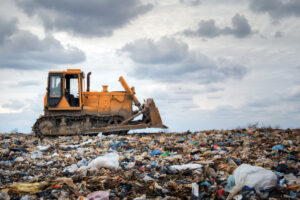According to EPA data, methane emissions from landfills are the third-largest source of human-related methane emissions in the United States, accounting for approximately 14.4% of these emissions in 2022.
“These emissions heat the atmosphere at about 80 times the rate of carbon dioxide over 20 years, but the methane that rises from the decomposing food and organic waste that ends up in landfills has thus far received much less attention in the fight against climate change than methane emissions from oil and gas infrastructure,” according to clean energy research site Canary Media.
New Source Performance Standards (NSPS) background
- 2016: The EPA announced final updates to its NSPS to reduce emissions of methane-rich landfill gas from new, modified, and reconstructed municipal solid waste (MSW) landfills. In a separate action, the EPA also issued guidelines for reducing emissions from existing MSW landfills.
- 2017: The EPA announced it’s reconsidering certain aspects of the 2016 final rules for MSW NSPS and emissions guidelines (EGs). The EPA still intends to complete the reconsideration process granted by the administrator.
- August 2019: The EPA issued two actions related to timing and implementation of the 2016 EGs for existing MSW landfills:
- A final rule to align state plan timing requirements with the updated Clean Air Act (CAA) Section 111(d) implementing regulations that were finalized with the Affordable Clean Energy rule on July 8, 2019.
- A proposed federal plan in response to a court order for the EPA to finalize a federal plan by November 6, 2019. That court order has since been stayed pending an appeal.
- February 2020: The EPA amended the NSPS and EG to allow landfills subject to the National Emissions Standards for Hazardous Air Pollutants (NESHAP) to opt in to certain compliance provisions.
- March 2020: The EPA issued a notice of finding of failure to submit state plans, identifying 42 states and territories that failed to submit for review and approval state plans to implement the 2016 EG for MSW landfills. This finding doesn’t establish sanctions for states that have failed to submit state plans or set deadlines for imposing sanctions.
Current landfill methane emissions regulations
Landfills designed to hold more than 2.5 million tons of waste are required to install gas collection systems (which is a system of pipes designed to remove methane from waste piles) or prove that the landfills emit less than 50 megagrams (Mg) per year of non-methane organic compounds, including smog-causing volatile organic compounds (VOCs) and air toxics, according to an EPA Fact Sheet.
“The gas is then burned, releasing carbon dioxide, which is less damaging to the climate than the rapid warming brought on by methane. In some cases, methane is burned off at the landfill site, either underground or using flares,” Canary Media adds. “[Many] landfills use the gas to produce electricity or refuel garbage-collection vehicles, or it may even be pumped into existing natural-gas networks.”
The regulations also require surface emissions monitoring on a quarterly basis, which means a person is required to cross the landfill at about 100-foot intervals with an air sensor measuring methane emissions.
“If methane is measured at above 500 parts per million, it is considered an exceedance, and the EPA requires the landfill operator to take corrective action, such as adding additional soil coverage that helps with oxidation of organic material,” the Canary Media article continues. “The operator has to go back and measure again to ensure methane emissions have decreased.”
The problems with current landfill regulations, according to experts, are:
- Smaller landfills below the federal regulations threshold still emit significant amounts of methane.
- For systems with gas collection pipes, there are no maintenance requirements to check existing pipes for cracks and leaks.
- With any human monitoring systems, there are opportunities for errors, meaning methane leaks may go unnoticed.
“A study published in March in the journal Science concluded that landfill methane emissions were on average 40 percent higher than what’s reported to the EPA. The study, which surveyed over 200 active U.S. landfills using airborne sensors to detect methane plumes, found that 52 percent of surveyed landfills had observable emissions, and more than half of those plumes continued for months or years,” the Canary Media article says. “In May, Industrious Labs, a group that works to clean up industrial sources of climate pollution, analyzed EPA inspection reports from 29 landfills and found more than 711 methane exceedances above the 500 ppm (parts per million) limit. In many cases, the landfill operators had not detected any exceedances when conducting standard quarterly monitoring.”
State landfill best practices
Some states have adopted more stringent regulations, which may provide best practices modeling for tighter federal regulations. According to Canary Media, these best practices include:
- Lower thresholds for the requirement of the installation of gas collection systems.
- Required monitoring along tighter intervals.
- Some states require landfills to perform regular maintenance checks for leaky pipes, standing water, and other maintenance issues.
- The requirement for enclosed flares instead of open flares.
Canary Media notes that “the EPA said it is looking at ‘new and emerging technologies and new approaches that could be implemented’ to reduce landfill methane.”
Updated rules are long overdue, according to Katherine Blauvelt, circular economy director for Industrious Labs and an author of the report “The Hidden Cost of Landfills.”
“‘We have now airborne remote-measuring technology that is across the globe’ and detecting methane plumes, Blauvelt said” in the Canary Media article. “She wants the EPA to certify the use of technology such as satellites and drones for methane-emitting landfills and require operators to take immediate action. ‘Technology has advanced, and federal regulations have not caught up to those advancements.’”

